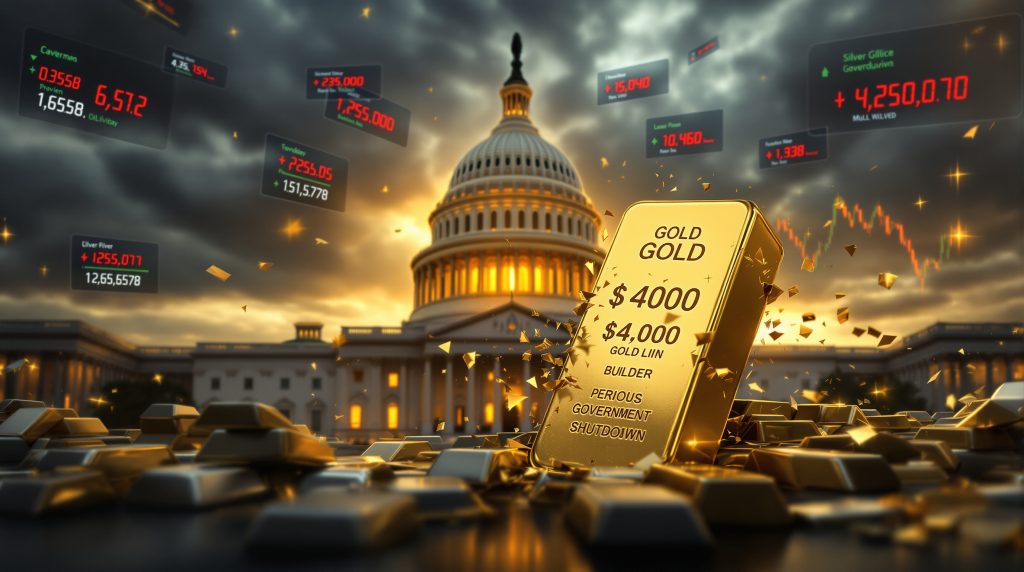Understanding the Gold Market During Political Uncertainty
Gold prices have historically responded with notable sensitivity to political uncertainties, with government shutdowns representing one of the most significant domestic political disruptions. These periods of fiscal and administrative impasse create distinct market conditions that often drive investors toward precious metals as a protective measure.
What Drives Gold Prices During Government Shutdowns?
Political instability inherently creates market uncertainty, which frequently propels investors toward safe-haven assets like gold. During government shutdowns, several key mechanisms activate simultaneously to influence gold pricing:
Market psychology plays a crucial role as investor sentiment shifts toward capital preservation rather than growth. This fear-based investment approach typically manifests as increased buying pressure in the precious metals market, particularly when combined with concerns about potential government debt ceiling breaches or long-term fiscal sustainability questions.
Historical data indicates that gold often experiences initial price gains during the early stages of a shutdown. However, these gains frequently diminish as the shutdown continues, especially once resolution appears imminent. This pattern reveals the market's dynamic risk assessment process—initial fear drives prices up, but adaptation and expectation of resolution moderates the momentum.
According to technical analysts, government shutdowns represent classic "event-driven" price movements rather than fundamental shifts in market dynamics. This distinction helps explain why gold price increases during shutdowns often prove temporary rather than establishing new long-term support levels.
Current Gold Market Fundamentals
Gold's recent breakthrough above $4,000 per ounce marks a significant psychological and technical milestone. This price level represents not just a round-number threshold but signals a potential shift in market perception of gold's fundamental value proposition.
The technical indicators surrounding this achievement warrant careful attention. As of October 2025, gold has recorded seven consecutive weekly gains—a pattern that has historically signaled mature rallies. According to Paul Sienna, a technical analyst at Bank of America, this sequence of gains has been followed by lower prices four weeks later in all 11 prior recorded instances, suggesting the possibility of a correction.
Current price positioning relative to key moving averages further supports the mature rally thesis. Gold is trading approximately 21% above its 200-day moving average and sits a remarkable 70% above its 200-week average. Bank of America's technical team notes this 70% elevation above the 200-week average has only occurred three times historically—in 2011, 2008, and 2006—each instance eventually leading to gold prices analysis price adjustments.
The momentum analysis reveals gold has gained over 50% year-to-date, its strongest performance since 1979. While this extraordinary performance demonstrates robust investor demand, it also raises questions about sustainability, particularly as traditional buyers like jewelry consumers and central banks begin showing sensitivity to elevated price levels.
Historical Perspective: Gold Performance During Past Shutdowns
Understanding how gold has performed during previous government shutdowns provides essential context for predicting likely outcomes during current and future fiscal impasses. Two recent examples offer particularly relevant insights for today's investors.
Obama-Era Shutdown Effects (2013)
The 16-day government shutdown from October 1-17, 2013, occurred during an already challenging period for gold prices. Gold had been declining from its 2011 highs and entered the shutdown period at approximately $1,326 per ounce.
The initial price response followed the classic safe-haven pattern, with gold rallying about 3% during the first week of the shutdown. However, this momentum proved unsustainable as market sentiment shifted from crisis response to pragmatic assessment of eventual resolution.
As the shutdown continued, gold prices began to lose momentum and actually declined during the latter stages of the impasse. By the time the shutdown ended on October 17, gold had given back most of its initial gains, closing near $1,320.
The post-resolution trend revealed an important pattern that has informed investor expectations during subsequent shutdowns: once political resolution became clear, gold experienced additional selling pressure as the "crisis premium" evaporated from the market. Within two weeks after the shutdown ended, gold prices had fallen below pre-shutdown levels, demonstrating how quickly sentiment-driven gains can reverse.
Trump-Era Shutdown Impact (2018-2019)
The 35-day government shutdown from December 22, 2018, to January 25, 2019—the longest in U.S. history—provides an even more instructive case study. Gold entered this period trading around $1,256 per ounce amid broader market volatility.
The price volatility patterns during this extended shutdown differed somewhat from the Obama-era experience. Gold exhibited stronger and more sustained upward momentum, gaining approximately 6% during the shutdown period. This more robust performance likely reflected the shutdown's unprecedented length and the accompanying uncertainty about economic impact.
The correlation with fiscal uncertainty became increasingly evident as the shutdown continued past the three-week mark. Investors grew more concerned about potential impacts on economic data collection, policy implementation, and government operations, driving additional defensive positioning in precious metals.
The recovery timeline following resolution showed a more gradual normalization process than observed in 2013. Rather than an immediate reversal, gold prices consolidated near their elevated levels for several weeks before gradually declining as market focus shifted to other factors. This suggests that longer shutdowns may create more persistent effects on gold price dynamics.
Federal Reserve Policy Intersection
Government shutdowns create a unique policy environment that directly impacts Federal Reserve operations, creating a complex interplay between fiscal uncertainty and monetary policy that significantly influences gold prices.
How Delayed Economic Data Affects Monetary Policy
When the government shuts down, many federal agencies stop collecting and publishing economic data, creating significant decision-making complications for the Federal Reserve. This data vacuum hampers the Fed's ability to accurately assess economic conditions and calibrate appropriate policy responses.
According to the Federal Reserve's September 2025 meeting minutes, officials projected two additional quarter-point interest rate cuts by year-end. However, the current shutdown threatens to disrupt this carefully telegraphed path by interrupting the flow of critical economic indicators.
The market anticipation surrounding this data disruption has created unusual positioning among bond traders, who are preparing for potential volatility once the shutdown ends and the backlog of economic reports gets released. As one market analyst noted, "Pent-up reports on employment and inflation could complicate the Fed's decision-making and create further turbulence in the Treasury market."
This data uncertainty particularly impacts gold because precious metals typically benefit from policy uncertainty—when the Fed lacks clear economic visibility, investors often increase safe-haven insights allocations. Additionally, any delay in implementing expected rate cuts due to data uncertainty could extend gold's current bull run by maintaining accommodative monetary conditions.
Interest Rate Environment
The current interest rate trajectory remains supportive for gold prices. Goldman Sachs forecasts approximately 100 basis points of rate cuts by mid-2026, continuing the declining rate environment that has contributed to gold's remarkable 2025 performance.
Lower interest rates enhance gold's relative appeal through several mechanisms. Most directly, they reduce the opportunity cost of holding non-yielding assets like gold. When yields on interest-bearing investments decline, gold's zero-yield nature becomes less disadvantageous in relative performance calculations.
The real yield correlation represents one of the strongest statistical relationships in the gold market. As inflation-adjusted yields on government securities decline, gold prices typically rise. This relationship has held particularly strong in recent months as expectations for sustained rate cuts have pushed real yields lower.
The current shutdown complicates this picture by potentially delaying rate cuts if the Federal Reserve feels compelled to wait for clearer economic data. This policy limbo could create unusual price dynamics in the gold market—continuing support from expected future cuts, but potential volatility around Federal Reserve meetings where decisions might be postponed due to data inadequacy.
Current Market Positioning and Risk Factors
The technical position of gold presents a mixed picture that combines historically bullish momentum with several warning signs that warrant careful consideration by investors.
Technical Analysis Perspectives
Several prominent technical indicators suggest gold may be approaching overbought territory. Most notably, Bank of America's technical team highlights that gold is trading approximately 21% above its 200-day moving average—a level where peaks have historically become more common.
Even more striking is gold's position approximately 70% above its 200-week average, a condition observed only three times in recent history (2011, 2008, and 2006). Each of these previous instances preceded significant price corrections, though the timing and magnitude varied considerably.
The pattern of seven consecutive weekly gains adds another cautionary signal. According to Bank of America's analysis, this sequence has occurred 11 times previously, with lower prices following in all instances when measured four weeks later. This historical precedent suggests increased probability of at least a short-term pullback.
Despite these warning signs, technical analysts have not ruled out further upside. Some analyses suggest that if the current rally mirrors the structure of previous bull markets, prices could potentially reach $5,000 or even $7,000 per ounce. However, most technical observers characterize the current move as mature and vulnerable to at least a temporary correction.
Potential Correction Triggers
Several specific factors could potentially trigger or accelerate a correction in gold prices:
Margin requirement changes represent a particularly significant risk. As prices rise to record levels, exchanges often increase margin requirements for futures contracts to manage systemic risk. These higher capital requirements can force leveraged traders to liquidate positions, potentially creating selling cascades if multiple participants need to exit simultaneously.
Profit-taking scenarios become increasingly likely as prices reach psychological thresholds and round-number targets. The recent achievement of $4,000 per ounce could motivate investors who established positions at much lower levels to lock in gains, particularly if technical indicators suggest momentum may be waning.
Post-shutdown sentiment shifts could significantly impact prices once the current fiscal impasse resolves. Historical patterns from previous shutdowns indicate gold typically loses momentum once resolution occurs and the crisis premium begins to evaporate from market pricing. This pattern appears consistent across both the Obama-era (2013) and Trump-era (2018-2019) shutdowns, suggesting a similar reaction remains likely when the current situation resolves.
Bernard Dada at Natixis anticipates "potential turbulence ahead in the next two to three months before gold resumes its climb in 2026," highlighting that similar rallies ended with 5-10% drops within days during previous periods of acute uncertainty, including the 2011 debt ceiling crisis, the pandemic in 2020, and the 2022 Ukraine war.
Investment Capital Flows During Shutdowns
Understanding the movement of investment capital during government shutdowns provides crucial context for anticipating gold price movements, as these flows often reflect broader risk assessments and portfolio adjustments.
Treasury Market Dynamics
One of the most striking developments in the current financial environment has been the unprecedented pace of outflows from US Treasury securities. These outflows reflect investor concerns about both fiscal sustainability and the operational impacts of the government shutdown.
Following what market participants have termed "Liberation Day" in early October 2025, money market funds experienced approximately $150 billion in outflows within just two weeks. This massive capital movement represents investors seeking alternative placements for funds previously held in government-related securities.
The reallocation patterns of this capital will substantially influence gold's price trajectory. While the gold market remains relatively small compared to government bond markets, even modest percentage reallocations can create outsized price impacts. Analyst estimates suggest that if just 1-2% of these outflows redirect toward gold, prices could potentially rise another 10% from current levels.
This dynamic highlights one of gold's fundamental market characteristics—its limited market depth relative to major asset classes means that relatively small capital flows can generate substantial price movements, particularly during periods of heightened uncertainty.
ETF and Institutional Positioning
Western exchange-traded funds have shown remarkable inflow strength in recent months, reflecting growing institutional interest in gold exposure. Goldman Sachs analysis indicates these inflows have remained sustainable rather than speculative, noting that "speculative positioning has remained stable, suggesting that recent ETF strength is not an overshoot."
This stability in futures market positioning despite significant price rallies suggests the current gold market surge may have more sustainable structural support than previous bull markets that featured more speculative positioning. The contrast between stable futures positioning and strong ETF inflows indicates predominately investment-oriented rather than speculative demand.
Institutional outlook remains generally positive, with Goldman Sachs recently raising its bull case price target to $4,900 per ounce by December 2026, up from a previous forecast of $4,300. The bank cited "strong Western ETF inflows and continued central bank buying as the drivers" while noting that "the risks to his forecast remain skewed to the upside because private sector diversification into the relatively small gold market may push ETF holdings higher than expected."
This institutional perspective highlights how the government shutdown fits within a broader narrative of uncertainty that continues to drive diversification-oriented investment flows toward precious metals.
Demand Destruction Risks at Record Prices
While investment demand has driven gold to record levels, these elevated prices create significant challenges for traditional demand segments that have historically provided market stability.
Traditional Buyer Behavior
The jewelry market typically shows strong price elasticity, with consumer demand declining substantially as prices rise. At current record levels above $4,000 per ounce, jewelry fabrication has begun showing significant signs of demand destruction in price-sensitive markets like India and China.
This sensitivity matters considerably because jewelry fabrication has traditionally represented approximately 50% of annual gold demand. When combined with technology uses and central bank purchases, these traditional demand segments collectively account for approximately 70% of global gold consumption.
Central bank purchasing has also shown signs of slowing from the record pace observed in 2022-2024. While emerging market central banks continue diversifying reserves into gold, the pace has moderated as prices have escalated. Goldman Sachs projections suggest central banks will purchase approximately 80 metric tons in 2025 and 70 tons in 2026—significant volumes but reduced from previous years.
This pullback from traditional buyers creates a market dependency on continued investment demand to sustain current price levels. As one market analyst observed, "The risk is demand destruction. At these levels, jewelry buyers are walking away and central banks are slowing their purchases."
Long-Term Price Sustainability Factors
Despite these demand concerns, several factors suggest potential for continued price support:
Private sector diversification trends have accelerated in response to geopolitical uncertainties and inflation hedge analysis concerns. The relatively small size of the gold market compared to global bond and equity markets means even modest portfolio reallocations can sustain price momentum. Goldman Sachs specifically noted that "private sector diversification into the relatively small gold market may push ETF holdings higher than expected."
Central bank projections, while showing moderation, still indicate substantial official sector demand. The expected purchasing of 80 metric tons in 2025 and 70 tons in 2026 represents continued diversification among emerging market monetary authorities away from traditional reserve currencies and toward hard assets.
Market size constraints fundamentally amplify price movements in both directions. Gold's limited annual production (approximately 3,500 metric tons) combined with its concentrated ownership structure means supply and demand imbalances can create outsized price responses. This structural feature supports the argument that even with some traditional demand erosion, continued investment flows can sustain elevated prices.
The demand destruction dynamic creates a market tension that will likely contribute to increased price volatility going forward. If investment demand moderates while traditional demand remains suppressed by high prices, a more substantial correction could materialize. Conversely, if investment flows accelerate despite reduced traditional demand, prices could continue rising to levels that further exacerbate the demand destruction cycle.
Silver as an Alternative Precious Metals Play
As gold prices have accelerated to record levels, investor attention has increasingly shifted toward silver as an alternative precious metals investment with distinct characteristics and potential advantages.
Investment Rotation Dynamics
The crowding effect in gold becomes increasingly evident as prices reach psychological thresholds and technical indicators suggest potential overbought conditions. This environment typically promotes rotation toward silver, which many investors perceive as offering similar safe-haven benefits with greater upside potential from current levels.
Market observers have noted that "investors who see the gold trade as too crowded are rotating into silver," reflecting this typical pattern of late-cycle precious metals investing. Lewis Vincent Gav at Gavcow Research observes that "once a bull market in precious metals starts, it usually takes a hawkish Federal Reserve or a sharp rise in the dollar to stop it. Neither appears likely right now."
The comparative value proposition for silver becomes particularly compelling during times of government uncertainty combined with accommodative monetary policy. Silver's relative affordability compared to gold makes it accessible to a broader range of investors, while its industrial applications provide an economic growth component that pure monetary metals lack.
Price correlation patterns between gold and silver typically show silver following gold's directional movements but with amplified volatility. This characteristic makes silver particularly attractive during established precious metals bull markets, as silver typically outperforms during the later stages of these cycles.
Silver's Industrial Demand Evolution
One of the most significant developments in the silver market has been the ongoing application transition from traditional uses toward high-value technology applications. While photography once represented a major demand segment for silver, digital technology reduced this application substantially.
However, new industrial applications have emerged that potentially support higher structural demand levels. The integration of silver into advanced technologies, particularly in renewable energy, electronics, and emerging AI applications, has created growing industrial consumption that adds fundamental support to investment demand.
Paul Wong at Broad Asset Management argues that "for silver to keep rising, demand must shift from low value uses like photography to high-value applications like AI. If silver breaks above $50 sustainably, it could signal a repricing of the metal's economic worth."
This potential economic value repricing above $50 per ounce would represent a fundamental reassessment of silver's industrial importance within a technology-driven economy. Such a repricing could establish a new long-term support level substantially above historical averages, particularly if government shutdown concerns continue to drive precious metals investment demand in the near term.
The combination of industrial utility and monetary characteristics positions silver uniquely during government shutdowns—offering both safe-haven appeal similar to gold and economic recovery potential once fiscal resolution occurs.
Expert Price Projections and Outlook
Financial analysts and investment banks have published diverse projections for gold's future trajectory, with particular attention to how the current government shutdown might influence price dynamics.
Bull Case Scenarios
Goldman Sachs recently upgraded its gold price forecast, establishing a target of $4,900 per ounce by December 2026, revised upward from a previous projection of $4,300. This bullish outlook rests primarily on expectations for "strong Western ETF inflows and continued central bank buying."
The upside risk factors identified by Goldman Sachs focus particularly on private sector allocation decisions, with the bank noting that "risks to his forecast remain skewed to the upside because private sector diversification into the relatively small gold market may push ETF holdings higher than expected."
Historical comparison to previous bull markets offers additional context for potential upside scenarios. Bank of America technical analyst Paul Sienna acknowledges the possibility of further upside to $5,000 or even $7,000 if the current rally follows structural patterns similar to previous bull markets, though he cautions about near-term vulnerability to correction.
While these targets may seem ambitious, it's important to recognize that previous gold bull markets have typically culminated in price levels that appeared extreme by historical standards. The 1980 peak of $850 represented an 8x increase from decade-earlier prices, while the 2011 peak of $1,921 reflected a similar magnitude of increase from early 2000s levels.
Bear Case Considerations
Despite bullish longer-term projections, several analysts have highlighted significant technical vulnerability in the current gold market. Bank of America's technical team specifically warns that "the current move is mature and vulnerable to a correction" based on multiple indicators.
The historical pattern analysis of seven consecutive weekly gains represents a particularly noteworthy warning signal. According to Bank of America, this sequence has occurred 11 times previously, with lower prices following in all instances when measured four weeks later.
The demand destruction timeline presents another concern for sustained high prices. Traditional buyers like jewelry consumers and central banks collectively represent approximately 70% of normal gold demand, and both segments show signs of reduced purchasing at current price levels. This erosion of traditional demand creates increased dependency on continued investment flows to maintain price levels above $4,000.
Bernard Dada at Natixis expresses a relatively balanced view, anticipating "potential turbulence ahead in the next two to three months before gold resumes its climb in 2026." This perspective acknowledges near-term correction risk while maintaining a constructive longer-term outlook.
Investment Strategies During Government Shutdowns
Government shutdowns create unique market conditions that require specialized investment approaches to manage both risks and opportunities in the precious metals sector.
Portfolio Positioning Approaches
During periods of government shutdown uncertainty, several profit protection techniques warrant consideration. For investors with substantial unrealized gains from the recent rally, partial profit-taking represents a prudent approach to secure returns while maintaining exposure to potential further upside.
Another strategy involves implementing trailing stop orders at predetermined percentages below current market prices. This approach allows participation in continued upward movements while establishing automatic exit points if momentum reverses. Given gold's recent volatility profile, stop levels between 5-8% below current prices provide reasonable protection without excessive risk of premature execution.
Entry point considerations become particularly important during government shutdowns, as price volatility often increases. Rather than establishing full positions at current levels, investors might consider employing a systematic averaging approach—allocating predetermined capital amounts at regular intervals or at specific technical levels. This approach reduces timing risk during periods of heightened uncertainty.
Diversification within precious metals offers another strategic approach during government shutdowns. Allocating exposure across gold, silver, and select mining equities provides balanced exposure to the sector while reducing concentration risk in any single instrument. Silver typically offers higher volatility and potential for outperformance during later stages of precious metals bull markets, while quality mining equities can provide operational leverage to metal prices.
Risk Management Frameworks
Position sizing guidelines gain particular importance during government shutdowns when volatility typically increases. Financial advisors generally recommend limiting precious metals exposure to 5-10% of total portfolio assets during normal market conditions, with potential for modest increases during periods of specific political uncertainty like shutdowns.
Within that allocation, further diversification across physical metals, ETFs, and select mining companies reduces instrument-specific risk while maintaining sector exposure. Conservative investors might weight toward physical metals and major ETFs, while those with higher risk tolerance might include junior mining companies with greater operational leverage.
Volatility preparation requires establishing realistic expectations before government shutdown impacts fully materialize. Gold price movements of 1-2% daily become increasingly common during shutdowns, with occasional single-day movements exceeding 3%. Mentally preparing for this volatility reduces the likelihood of emotional decision-making during market fluctuations.
Exit strategy development should occur before positions are established rather than in response to market movements. Defining specific technical levels, fundamental developments, or time-based criteria for reducing exposure provides objective guidance during periods when political news and market volatility can cloud judgment.
Post-Shutdown Market Expectations
Understanding how markets typically behave once government shutdowns conclude provides investors with valuable preparation for the eventual resolution phase.
Historical Resolution Patterns
Price action precedents from previous shutdowns suggest gold typically loses momentum once resolution becomes apparent. During both the Obama-era (2013) and Trump-era (2018-2019) shutdowns, gold prices surrendered some or all of their shutdown-related gains once fiscal impasse resolution became clear.
This pattern reflects the gradual dissipation of the crisis premium embedded in gold prices during shutdowns. As uncertainty diminishes, the safe-haven demand that drove initial price increases naturally moderates. However, the extent and pace of this moderation varies considerably depending on broader market conditions and monetary policy expectations.
Volatility timelines following shutdown resolution typically show elevated price movement for 2-3 weeks after the government reopens. This extended volatility reflects the market's process of digesting backlogged economic data and reassessing monetary policy implications based on the newly available information.
Sector rotation tendencies following shutdown resolution generally show a shift from defensive positioning toward more growth-oriented assets. This rotation can create headwinds for precious metals in the immediate post-shutdown period as capital reallocates toward equity markets and away from safe-haven assets.
Economic Data Catch-Up Impact
Employment report influence becomes particularly significant following shutdowns because labor market data directly impacts Federal Reserve policy decisions. When multiple employment reports are delayed and then released in close proximity, the market must quickly process substantial information that might otherwise have been digested gradually.
Inflation reading significance similarly increases after shutdowns, particularly in the current environment where inflation concerns have substantially influenced Federal Reserve policy. Delayed inflation data can create pronounced market reactions if figures deviate significantly from expectations or show clear directional trends across multiple reporting periods.
Growth metric implications round out the critical post-shutdown data picture. GDP reports, productivity data, and manufacturing indices provide comprehensive economic assessment that shapes both monetary policy expectations and risk sentiment. The interpretation of this data can significantly influence whether gold maintains shutdown-driven price gains or surrenders them as market focus shifts from political to economic fundamentals.
The combination of these data releases creates a particularly challenging environment for precious metals in the weeks immediately following shutdown resolution. Investors should prepare for potentially significant price volatility during this "data catch-up" period as markets recalibrate to the new information environment.
FAQ: Gold Investment During Government Shutdowns
What typically happens to gold prices when a government shutdown ends?
Historical patterns indicate that gold often loses momentum after shutdown resolution as uncertainty diminishes and risk appetite returns to markets. During both the 2013 and 2018-2019 shutdowns, gold surrendered portions of its gains once resolution became apparent. The magnitude of this post-resolution decline typically correlates with how much "crisis premium" built up during the shutdown period and how quickly economic conditions normalize afterward.
How do government shutdowns affect the Federal Reserve's monetary policy decisions?
Shutdowns disrupt economic data collection and reporting, complicating the Fed's ability to assess economic conditions and potentially delaying policy adjustments. This data vacuum creates particular challenges when shutdowns coincide with planned Federal Reserve meetings or occur during periods of potential policy transition. The Fed relies heavily on timely economic indicators to calibrate monetary policy, and shutdown-related data gaps can force officials to delay decisions or rely more heavily on private sector data sources.
Is the current gold rally sustainable or approaching a correction?
Technical indicators suggest the rally is mature, with gold trading significantly above key moving averages and showing patterns that have historically preceded corrections. Gold's position approximately 70% above its 200-week average has only occurred three times historically (2011, 2008, and 2006), with each instance eventually leading to price adjustments. Additionally, the pattern of seven consecutive weekly gains has historically been followed by lower prices in all 11 previous instances. While longer-term forecasts remain constructive, these technical signals suggest increased probability of near-term consolidation or correction.
How does silver typically perform relative to gold during government shutdowns?
Silver often follows gold's direction but with greater volatility, sometimes outperforming when investors view the gold trade as overcrowded. This amplified volatility stems from silver's smaller market size and dual role as both monetary and industrial metal. During the later stages of precious metals rallies, including those accelerated by government shutdowns, silver frequently outperforms as investors seek relatively undervalued alternatives within the sector.
What percentage of a portfolio should be allocated to gold during political uncertainty?
Appropriate allocation varies by individual circumstances, but many advisors suggest 5-10% in precious metals as a portfolio diversification strategy during uncertain periods. This allocation might increase modestly during acute political uncertainty like government shutdowns, particularly for investors with lower risk tolerance or specific concerns about fiscal stability. However, even during shutdowns, maintaining diversification across multiple asset classes remains prudent for most investors rather than dramatic shifts toward any single sector.
Ready to Navigate Gold Market Uncertainty During Government Shutdowns?
Discover how to strategically position your investments during periods of political instability with real-time insights from Discovery Alert's proprietary Discovery IQ model. Explore our dedicated discoveries page to understand how major market movements can create exceptional investment opportunities in the precious metals sector.




